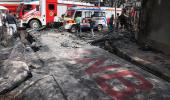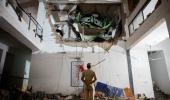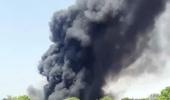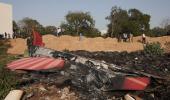'A few answers for the reason of the crash will be known -- whether it was a technical fault, design issue, human error etc.'

Retired Indian Air Force officer Wing Commander K Dinesh has investigated 12 major and minor air crashes (four fatal) as an aircraft accident investigator in the IAF.
He is also empanelled as an air accident investigator with the Aircraft Accident Investigation Bureau of India.
The Kargil veteran is founder of Cockpit Vista, a flying programme that helps anxious travellers overcome the fear of flying.
In an interview to Rediff's Archana Masih, Wing Commander Dinesh explains in simple terms what goes behind the highly specialised expertise of an air crash investigation.
What will the investigations into the Air India flight 171 crash entail? What will the investigators be looking for?
Air crash investigation is a highly specialised job.
The International Civil Aviation Organisation [ICAO] mandated by the United Nations defines the protocols for air accident investigation.
The United States is the role model for crash investigations. The National Transportation Safety Board is dedicated to investigating air accidents in the US.
India as a growing aviation economy has established its own Aircraft Accident and Investigation Bureau [AAIB] on the lines of NTSB.
AAIB comes under the ministry of civil aviation.
NTSB is an independent organisation.
What is the procedure for such investigations?
There is a set protocol which is described in minute detail in annexure 13 of the ICAO.
Air crash investigators reach the site and take charge. The area is cordoned off. Typically, they collect evidence in the initial two days to prevent it from getting lost or contaminated.
AAIB is the only agency mandated to carry out this task.
The moment the police and fire department declare the rescue phase over, the AAIB takes over.
After AAIB officials reach the spot, they form teams. For example, the flight data recorder team, engineering team, meteorology and weather team etc, and the investigation begins right away.

What is the first thing they look for?
The Flight Data Recorder [FDR] and the Cockpit Voice Recorder [CVR].
A modern digital Flight Data Recorder can actually simulate a flight as if the aircraft was flying right in front of you.
The Flight Data Recorder of a Boeing 787 captures more than 2,000 parameters.
AAIB gathers other data through photographs, videos and collects crucial objects.
The crash site has thousands of pieces, including human bodies and the investigators are trained to have an eye for everything that can give clues into the air crash investigation.
For example, how far did the engine fall from the main aircraft?
They spend hours gathering all information.
Once they have captured all possible information, the wreckage will be moved to a safe place and reconstructed which gives a lot of information about what happened.
There are countless technical and scientific aspects that are looked at and analysed from the wreckage.

Is the field phase of the investigation over by then?
Yes. Meanwhile, the police will clear the road and the municipality will clear the building and demolish it [if unsafe].
What is the involvement of other countries and agencies in the investigation?
In this case, accredited representatives will come from the manufacturer -- Boeing in the US.
The US will send NTSB nominees. Similarly, the UK -- all this is a part of the ICAO Annexure 13. It is all listed and has to be followed.
To that extent, air crash investigation is standardised across the world.
When is the AAIB likely to declare its findings?
The procedure demands that the NTSB or the AAIB in our case give the preliminary understanding of the crash within 4-5 days.
This information will come from the FDR analysis.
There is a very stringent procedure to milk out the FDR data. The FDR and CVR are most precious as they provide real-time information about what happened.
The Boeing 787 Dreamliner is equipped with an Enhanced Flight Recorder system. [This includes both a Flight Data Recorder (FDR) and a Cockpit Voice Recorder (CVR)].

For example, what crucial info does it give?
An FDR can reconstruct the story completely as to what happened. It is located in the tail of the aeroplane. We have seen footage showing that the tail has survived the crash and the FDR of AI 171 seems to be intact.
A FDR which is in perfect condition can be downloaded onto a standard downloading equipment for that purpose.
The FDR, in any case, is designed to survive. Only if it is damaged, then the complexity of extracting the data increases.
FDR investigators are a very specialised group.
Where will this data be milked?
India has a rudimentary FDR laboratory, but in this case, it could be sent to the US.
What are the timelines for publishing the reports?
Any update by the local administration, police, fire and NTSB too in the initial days (prior to the preliminary report), are called briefings. It can be daily or periodically (in the case of the PSA airline crash there were 4 briefings or so) that is done on need basis.
They are not mandated by ICAO but done as a practice. That's why our AAIB has not done the briefing in case of AI 171, but NTSB does for every major accident.
After the FDR reaches NTSB or our laboratory, the data download called raw data can be obtained in 4 to 5 days and a few answers for the reason of the crash will be known -- whether it was a technical fault, design issue, human error etc. This information is typically covered in the briefings.
According to the ICAO laid down rule it is mandatory to bring out the preliminary report in writing into public domain in 30 days' time. This is established industry practice internationally.
The raw data from the FDR download is validated within the 30 days. The preliminary report will therefore contain a few answers about why the crash happened, how it happened etc.
After that the investigators will dig deeper into all the hard evidence.
The final report will take around 1 to 1.5 years.
The report provides information about critical issues that need to fixed and do not reoccur on other flights.
For example, the Boeing 737 Max was grounded after two passenger planes crashed in 2018-2019 due to issues with MCAS [Maneuvering Characteristics Augmentation System].

So the comprehensive report and all the reasons that caused the accident will be known only after a year-and-a-half?
The full report basically shows whether changes are required in engineering, design, pilot training module etc.
There are different specialist groups operating in every aspect of the investigation – like FDR, engine, hydraulics, human factor group, meteorology, aviation medicine group etc.
All these specialists are trained with an eye for investigation and independent view.
All of them work under an Investigator in Charge, the only person who has full information.
Since a video footage of the air crash is in the public domain, there is a lot of speculation.
The final report about what, how, why will come out only after one-and-a-half years.
The NTSB briefing of the PSA airline collision with a military helicopter over the Potomac river in Washington, DC in January 2025 is an example of the way information about crash investigations are given out.
They are read out, never given extempore.
There are so many theories and speculation about the reasons for the crash. What adverse effect does this have on the public and the investigation process?
There should only be a single source of information for a crash investigation because it is disrespectful to the victims to have information coming from different sources.
More so, it creates fear among passengers.
One must remember that the lifetime of a news item is about seven to eight days. People will remember whatever was said about the crash in those first few days. But the actual investigation reports will only start coming after 30 days.
When that report comes, trust me, out of these hundreds who are talking, reading, commenting, only ten will be interested.

What is India's history of past air crash investigations?
The AAIB was established in 2012. Prior to that, the DGCA used to do the investigations.
We have come a long way. The AAIB site has all the accident reports on its Web site.
The ICAO mandates that the information has to be out in the public domain.
The recommendations are then sent to concerned people to make the aircraft safer.
Photographs curated by Manisha Kotian/Rediff.com
Feature Presentation: Aslam Hunani/Rediff.com










